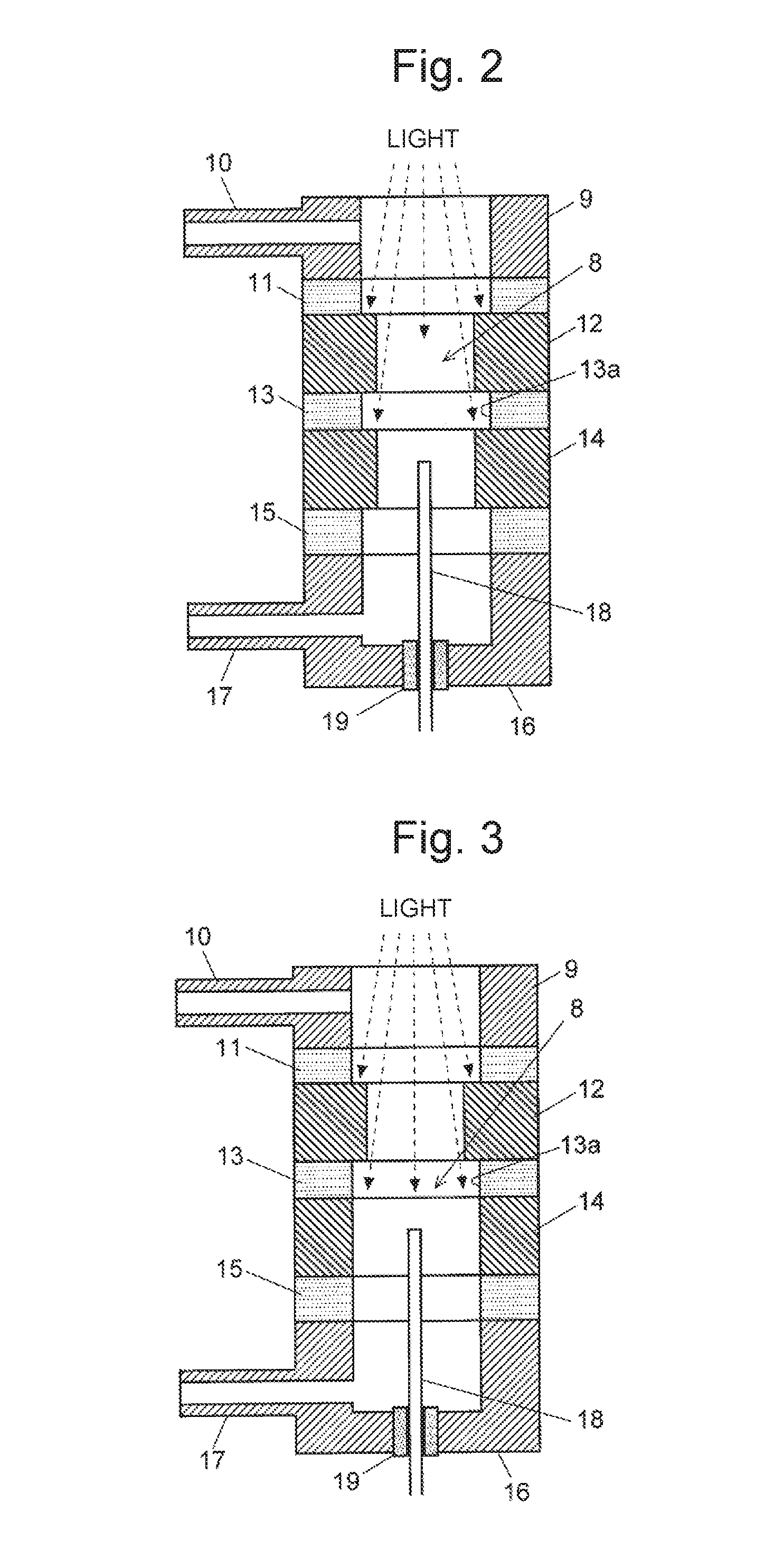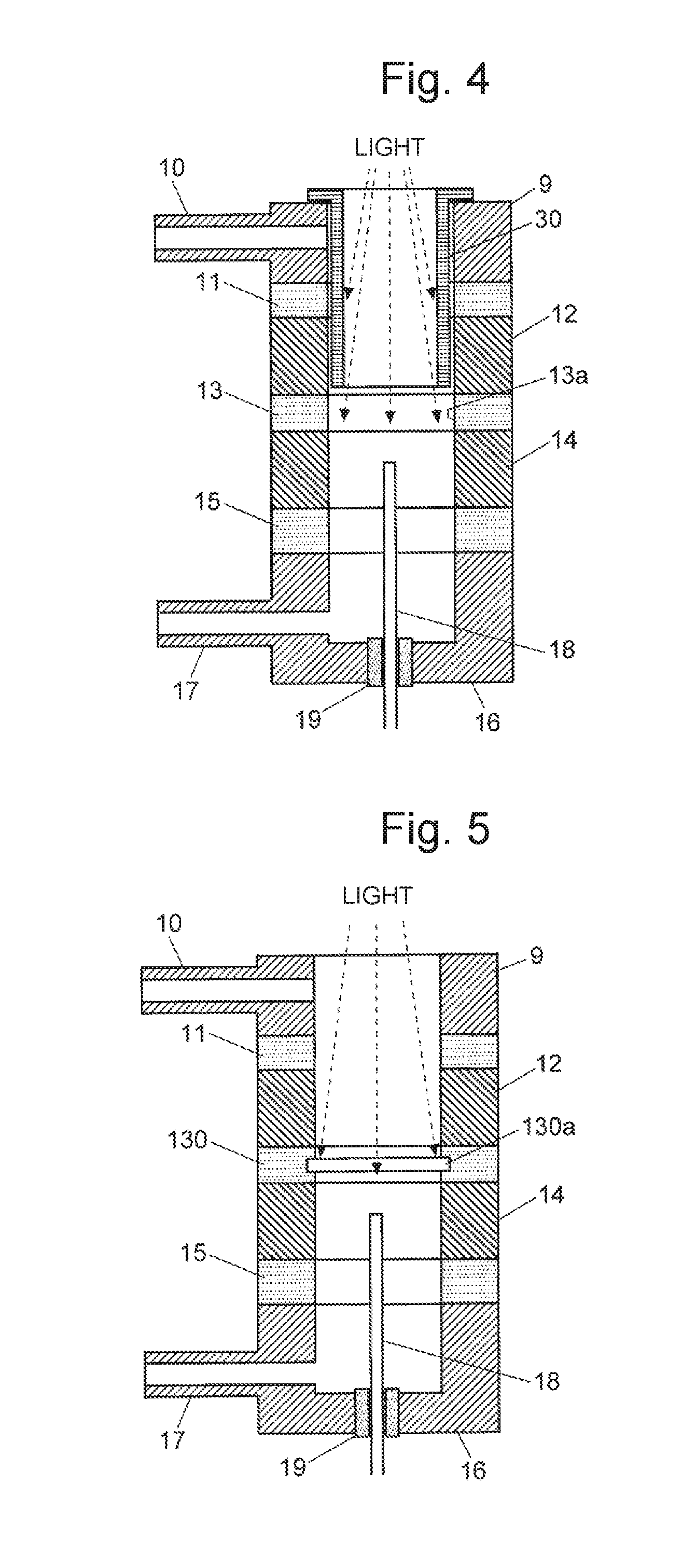Discharge ionization detector
a technology of ionization detector and discharge current, which is applied in the field of ionization detector, can solve the problems of low detection limit, low ionization efficiency of alcohol, aromatic substances, chlorine-based substances, etc., and achieve the effect of reducing baseline current, suppressing leakage current, and reducing baseline curren
- Summary
- Abstract
- Description
- Claims
- Application Information
AI Technical Summary
Benefits of technology
Problems solved by technology
Method used
Image
Examples
first embodiment
[0042]FIG. 1 is a schematic configuration diagram of a BID in a first embodiment. FIG. 2 is an enlarged view of an ion collector of the BID in this embodiment.
[0043]The BID of the present embodiment has a dielectric cylindrical tube 1 whose inner space serves as a first gas passage 2. On the outer wall surface of the dielectric cylindrical tube 1, annular plasma generation electrodes 3-5 made of an electrically conductive material (e.g. stainless steel or copper) are circumferentially provided at predetermined intervals in the flowing direction of the gas. A gas supply tube 6 is connected to the upper end of the dielectric cylindrical tube 1. Plasma generation gas that also serves as dilution gas is supplied through this gas supply tube 6 into the first gas passage 2. The wall of the dielectric cylindrical tube 1 between the first gas passage 2 and each of the plasma generation electrodes 3-5 functions as a dielectric coating layer which covers the surface of the plasma generation e...
second embodiment
[0053]FIG. 3 is an enlarged view of an ion collector of a BID in a second embodiment of the present invention. Components identical to those of the BID shown in FIG. 1 and FIG. 2 are denoted by the same reference signs.
[0054]In this BID in the second embodiment, the positional relationship between the bias electrode 12 and the insulating member 13 is the same as that in the first embodiment. As in the first embodiment, light from plasma is hardly cast on the surface 13a of the insulating member 13 because of light shielding by the bias electrode 12.
[0055]In the BID in the aforementioned first embodiment, the bias electrode 12 and the collector electrode 14 have the same inner diameter, and the same members can be used. However, the inner diameter of the collector electrode 14 is not necessarily the same as that of the bias electrode 12. An increase in baseline current is caused also by the photoelectric effect by light directly cast on the collector electrode 14. For this reason, av...
third embodiment
[0057]FIG. 4 is an enlarged view of an ion collector of a BID in a third embodiment of the present invention. In this BID in the third embodiment, the bias electrode 12, the insulating member 13 and the inner diameter of the collector electrode 14 are identical, and an additional light shielding member 30 is provided by being inserted into the second gas passage 8. The light shielding member 30 has such a shape that a flange is formed at one opened end of a cylindrical body. The light shielding member 30 is made of, for example, an insulator such as a machinable ceramic. In this BID in the third embodiment, light emitted from plasma is shielded by the cylindrical body of the light shielding member 30 and not cast directly on the surface 13a of the insulating member 13. Therefore, as in the aforementioned embodiments, leakage current between the bias electrode 12 and the collector electrode 14 is suppressed, whereby baseline current in a detection signal can be reduced.
PUM
| Property | Measurement | Unit |
|---|---|---|
| light energy | aaaaa | aaaaa |
| frequency | aaaaa | aaaaa |
| AC voltage | aaaaa | aaaaa |
Abstract
Description
Claims
Application Information
 Login to View More
Login to View More - R&D
- Intellectual Property
- Life Sciences
- Materials
- Tech Scout
- Unparalleled Data Quality
- Higher Quality Content
- 60% Fewer Hallucinations
Browse by: Latest US Patents, China's latest patents, Technical Efficacy Thesaurus, Application Domain, Technology Topic, Popular Technical Reports.
© 2025 PatSnap. All rights reserved.Legal|Privacy policy|Modern Slavery Act Transparency Statement|Sitemap|About US| Contact US: help@patsnap.com



